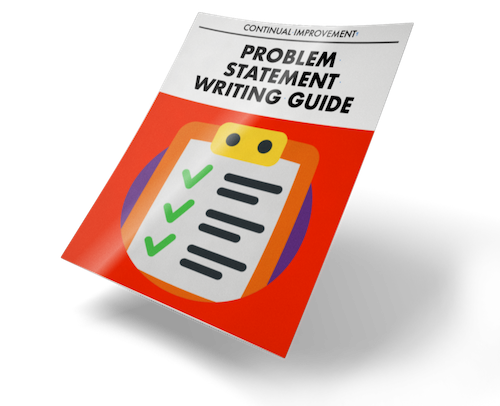What’s the problem you’re really trying to fix?
It might surprise you to hear that most people I interact with at the beginning of a project to solve a problem... aren’t able to answer this with absolute clarity.
Unfortunately, without a clear understanding of what the problem actually is, improvement project work always risks getting away from the starting blocks at a super slow pace.
COMMON ERRORS
#1 – The solution is disguised as a problem – e.g. We currently do not remotely work at the face until all seismic assessments have been completed
#2 – Multiple issues worked into a single statement, no real idea what to work on – e.g. People are spending time commuting, waiting at the pick up point, riding the tram to the work point, and performing ancillary activities that result in us losing time at the work face and production levels are lower than expected
#3 – Assumed causes written into the statement which pushes team down the wrong path – e.g. People are spending too much time assembling the reports which is preventing us from delivering the results on time
#4 – World hunger problem statement – e.g. Our operating costs are high, we need to lower them
#5 – Problem is stated as a benefit issue – e.g. We are not lowering the cycle time of our work sufficiently
#6 – Problem is stated as an opinion not an observation – e.g. It’s taking too long to complete the cycle of work
Every single one of these make it more challenging than it needs to be to properly and quickly solve the problem and generate some gains.
Here’s how you should do it.
CORRECTLY WRITING A PROBLEM STATEMENT
One of the first things you do as a business improvement practitioner is clearly define what your problem is in the form of a problem statement.
Park all that talk about it’s an ‘opportunity not a problem’ for a moment and let’s focus on how we state the observations properly.
A problem statement should simply state:
WHAT you observe (the performance gap you want fixed);
HOW LONG the situation or gap has existed, or been known to exist; and
THE IMPACT on the business or the potential gain from fixing the problem or improving.
STEP 1 – WRITING THE WHAT
The first part of a problem or opportunity statement is a simple description of what has been observed or experienced.
The most effective way to think of a problem or opportunity statement is to think about the gap in performance that you are observing.
The most effective statements simply describe the difference between the existing or current level of performance and a targeted level of performance. This targeted level of performance may be an existing target that is not being met, or a newly targeted level of performance established as a part of your continual improvement strategy.
Here’s some examples.
20 percent of calls have been placed on hold for 3 minutes or longer…
Time between order and installation is taking up to 7 days, which is 3 days longer than the targeted maximum of 4 days…
Throughput is averaging 210,000 tonnes per day, 30,000 tonnes short of the targeted 240,000 tonnes per day….
23 percent of applications have insufficient details to process payment without contacting the customer…
STEP 2 – WRITING THE HOW LONG
The second part of a problem or opportunity statement is to state how long the gap has existed or been known to exist.
For at least the past 3 months, 20 percent of calls have been placed on hold for 3 minutes or longer…
Time between order and installation is taking up to 7 days, which is 3 days longer than the targeted maximum of 4 days and this has been happening for at least 12 months….
Over the last 7 months, throughput has averaged 210,000 tonnes per day, 30,000 tonnes short of the targeted 240,000 tonnes per day…
23 percent of applications submitted over the past quarter, have insufficient details to process payment without contacting the customer…
STEP 3 – WRITING THE IMPACT OF THE PROBLEM
To demonstrate the link to the business case, the statement includes a description of the impact or significance of the problem, or alternatively, the benefits that could be gained by doing the work and capturing the opportunity that exists.
Again, let me give you some examples.
For at least the past 3 months, 20 percent of calls have been placed on hold for 3 minutes or longer, which has resulted in a 50 percent increase in the number of complaints from customers.
Time between order and installation is taking up to 7 days, which is 3 days longer than the targeted maximum of 4 days, this has been happening for at least 12 months and has cost the business 12 potential sales per month valued at $56,000.
Over the last 7 months, throughput has averaged 210,000 tonnes per day, 30,000 tonnes short of the targeted 240,000 tonnes per day, resulting in missed revenue opportunities of at least $25,000 per day.
23 percent of applications submitted over the past quarter, have insufficient details to process payment without contacting the customer, which results in an average of 12 hours per month spent following up on applications and lost sales to the value of $22,000 per month.
PROBLEM QUANTIFICATION
You would have noticed in the examples provided, quantitative terms are used in each of the elements of the problem statements. By using quantitative terms, you can:
(a) Be clear about the level of improvement you have achieved post solution implementation
Identify the benefits to the business in terms understood by the business leaders – this is your business case for doing this project
(b) Identify goals for the project work
Often the exact detail might not be known at this immediate point in time. I simply insert an ‘X’ where I don’t know the value, and as I learn more about the process I come back and amend the statement.
Check Your Problem Statement is NOT Like These
BE VAGUE – accelerated action and real progress will only come from focus, and statements that are specific and precise serve to ensure focused action
STATE OPINIONS – we are all entitled to our own opinions, but not our own facts so state what you observe (it takes 3 days to process the report), not what you interpret from that observation (it takes too long to process the report)
ASSIGN BLAME OR RESPONSIBILITY – a sure way to start conflict with people who may be those you need to generate improvements (it takes 3 days to process the report because the writer is lazy)
DESCRIBE A CAUSE – this assumes the cause and may lead to an erroneous solution (it takes 3 days to process report because the length of the report is 10,000 words)
ALLUDE TO A SOLUTION – again, the solution may be erroneous, the team is responsible for determining the solution once root causes are validated (it takes 3 days to process report because we don’t have enough staff)
CONSOLIDATE MULTIPLE PROBLEMS INTO A SINGLE STATEMENT – the impact of this is lost focus, and focus is the key to being able to act (it takes 3 days to process the report and we make a minimum of 20 typing errors)
Having Trouble Getting to the Problem?
One question that may help break the pattern of thinking when you get stuck is this. Ask the team “How do you know you have a problem?”
This may take the discussion towards the problem from a different angle.
Cheers
George Lee Sye




